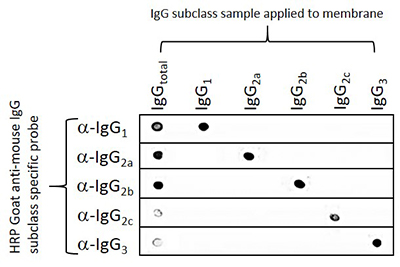
"I have used a wide variety of secondaries and Jackson ImmunoResearch has consistently been the best. The fluorophores are bright and stable and their selective (x reactivity removed) secondaries have always shown species specificity in multiple labeling."
Janet Duerr, Ohio UniversityRating: 5.0
Mice express four of the five available IgG subclasses making up their IgG isotype. The four IgG subclasses work in synergy as part of the mouse immune response. Mice typically encode for IgG1, IgG2b, and IgG3 and, depending on their strain, will express either IgG2a or IgG2c (Collins 2016). IgG2a, IgG2b, and IgG2c subclasses have similar functions (Collins 2016).

Inbred mouse strains, such as BALB/c and Swiss Webster mice, possess the Igh1-a allele, which results in the expression of IgG2a, the gene for IgG2c being absent. Whereas in mouse strains such as C57Bl/6, C57Bl/10, SJL, and NOD mice, the IgG2a gene is deleted. The possession of an Igh1-b allele results in the expression of IgG2c instead of the IgG2a subclass (Martin et al. 1998).
Several monoclonal antibodies originate from inbred stains, and some IgG2c clones have been incorrectly isotyped as IgG2a by reagents that cannot distinguish between these two subclasses. Subclass-specific antibodies from Jackson ImmunoResearch can be used to discriminate between the subclasses accurately.
| Mouse strain | Allele | IgG Subclass |
|---|---|---|
| C57BI/6 | Igh1-b | IgG2c |
| C57Bl/10 | ||
| SJL | ||
| NOD | ||
| BALB/c | Igh1-a | IgG2a |
| Swiss Webster |
Jackson ImmunoResearch Anti-Mouse IgG, subclass specific antibodies offer specificity to the five individual mouse IgG subclasses. These highly specific antibodies are designed to distinguish between two or more different subclass of mouse IgG in multiple labeling experiments or for mouse IgG subclass determination.
They are minimally cross-reactive against human, bovine, and rabbit serum proteins to minimize interference from cross-reactivity with tissue immunoglobulins, adherent bovine IgG on cultured cells, and rabbit-derived primary antibodies.
Anti-Mouse IgG, subclass specific antibodies are available conjugated to Alexa Fluor® and Cyanine™ Fluorescent dyes, Biotin-SP™, and horseradish peroxidase and alkaline phosphatase reporter molecules.
The example below illustrates the performance of the Goat Anti-Mouse subclass specific antibodies in a dot blot experiment. In each case, the subclass specific antibody only recognizes its specific target in the presence of additionally blotted subclasses.

*Subclass specific antibodies are not necessary for general detection of mouse monoclonal antibodies in single-labeling experiments or in multiple-labeling experiments involving one mouse monoclonal and primary antibodies from other species.